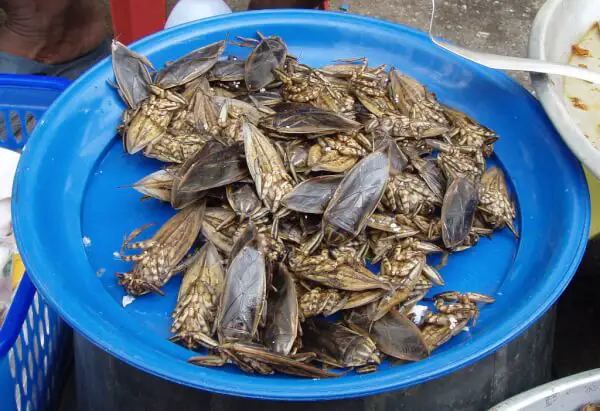Which statement comes closest to expressing your personal view of edible insects?
- “As unappetizing as it sounds, earthworms, grubs, ants, and grasshoppers can provide a last ditch effort to prevent starvation in a survival situation.” Or…
- “With the largest biomass of any terrestrial animal, insects may provide a sustainable food supply for the future of mankind.”
If you were to turn to edible insects as a source of food in a wilderness survival situation, you would be participating in a starvation avoidance strategy that is millions of years old. In fact, some anthropologists speculate that we are hardwired to eat insects and that the real “Paleo Diet” included lots and lots of insects.
That would appear to be borne out by the fact that today 80 percent of the world’s population eats insects as a regular part of their diet. Ants, bees, termites, caterpillars, water bugs, beetle larva, flies, crickets, katydids, cicadas and dragonfly nymphs are just a few of the insects that provide every-day nutrition for the people of Australia, Africa, South America, the Middle East and the Far East.
See also: Backpacking Food Tips: Tricks and Treats for the Trail
In fact, Americans are among a minority of the world’s population that has had a long-standing prejudice against eating insects. But this might be changing. What’s more, it’s changing at an increasingly rapid rate. Is the embracing of edible insects in America going to be similar to the love affair with sushi?
That began in Los Angeles in 1966 and spread like wildfire across the country until today you can find a sushi bar in just about every Kroger. Time will tell. But it seems to have a good start.
There are edible insect recipes, below and links to edible insect cookbooks where you can find more.
There are restaurants in Texas, Louisiana and Virginia, to name only a few states, where edible insects are a specialty. You can buy crickets snacks on Amazon.
So let’s look at edible insects from two perspectives: one as an emergency food source in a survival situation, and the other as everyday food that may soon rival cows, pigs and chickens as a source of protein.
Most Popular Edible Insects Table
There are over 2,000 species of edible insects. Here are the top 50, with six of the most popular included in the table and the other 43 in the text below.
Amounts of protein, unsaturated fat, carbohydrates and other nutrients are shown when the figures were available. Comparisons with beef and chicken are shown in the bottom two rows.
| Insect | Serving Size | Protein | Fat | Carbohydrates | Other Nutrients |
| Beetles
(Depends on the type of beetle) | 3-5 oz. serving | 20 grams | Calcium, iron, zinc | ||
| Caterpillars | 3-5 oz. | 6.7 grams | 15% | 17% | Iron, potassium, copper |
| Ants | 3-5 oz. serving | 14 grams | |||
| Grasshoppers | 3-5 oz. serving | 14-28 grams | Depends on size | iron | |
| Crickets | 3.5 oz. | 13 grams | Depends on size | ||
| Locusts | 3-5 oz. | 60 grams | 12% | ||
| Beef
| 4 oz. | 29-36 grams | |||
| Chicken | 3.5 oz. | 30 grams |
50 Most Popular Edible Insects
Agave Weevils, Ants, Aphids, Bagworms, Bamboo Worms, Bees, Cactus Weevils, Centipedes, Christmas Beetles, Cicadas, Cochineals, Cockroaches, Crickets, Diving Beetles, Dragonflies and Damselflies, Earthworms, Emperor Moths, Flies, Giant Water Bugs, Golden Orb-Weavers;
Grasshoppers, Hornets, Hornworms, Huntsman Spiders, Jewel Beetles, June Beetles, Katydids, Locusts, Longhorn Beetles, Mayflies, Mealworms, Midges and Mosquitos, Mopane Worms, Palm Weevils, Rhinoceros Beetles, Scorpions, Silkworms, Stag Beetles, Stick Insects, Stink Bugs, Superworms, Tarantulas, Termites, Tiger Beetles, Wasps, Water Boatmen, Water Scorpions, Waxworms, Witchetty Grubs, Woodlice,
The Case for Eating Insects
There is a convincing argument to be made that edible insects are the food of the future.
- They Are Safe. “Insects have a bad rap. Most people see insects as pests or as dangerous. But it’s just the opposite. Insects are less dangerous and less of a problem for humans in terms of disease.
We do have concerns about disease jumping from animals like pigs and cows to humans. But there are no worries about a disease jumping from an insect to humans.
The more evolutionary distant we are from our food source, the less danger there is and there is almost zero chance that any disease that affects an insect could actually impact a human after it’s cooked.” California Academy of Sciences entomologist Brian Fisher - They Are Present in Huge Numbers. Some 900 thousand different kinds of insects are known. Most experts agree that there are more species of insects that have not been discovered than have been previously named.
Some estimates say that this figure is 2 million, but other estimates range as high as 30 million. Insects have the largest biomass of the terrestrial animals.
The New York Times has estimated that the world holds 300 pounds of insects for every pound of humans. - They Are Nutritious. Insects are the most abundant source of protein on the planet. Ounce for ounce many insects have the same amount of protein as beef. Locusts have more. They are rich in vitamins and minerals which are required in small amounts to ensure normal metabolism, growth and overall health.
Dutch entomologists Arnold van Huis said, “We have a food crisis, especially a meat crisis, and people are starting to realize that we need alternatives, and insects are just an excellent alternative.” - They Are Easy and Economical to Farm. Insects reproduce more rapidly and have shorter life span so they can be grown rapidly.
For example, crickets can lay 1,200 to 1,500 eggs in a 3-4 week period, whereas beef cattle have a 283-day gestation period and require about four breeding animals for each animal brought to market.
It takes 10 kilograms (22 lbs.) of grain to raise 1 kilogram (2 lbs., 3 oz.) of beef, whereas that same amount of grain could raise 9 kilograms (19 lbs., 13 oz.) of insects. - They Are Sustainable. Insects use less water than vertebrates because they obtain hydration directly from food.
Insects give off less greenhouse gasses than cows. “If we’re raising grasshoppers instead of cattle,” says David George Gordon, the author of The Eat-a-Bug Cookbook, “we could reduce greenhouse gas emissions by 20 percent. We could be saving water, food and protecting the planet.” - They Taste Good. Peter Menzel, the author of Man Eating Bugs, describes joining Australian Aborigines eating witchetty grubs which tasted like “nut-flavored scrambled eggs and milk mozzarella, wrapped in a phyllo dough pastry.”
Mostly, our tastes are what we are used to. The first American sushi restaurant opened in Los Angeles in 1966 and was a revolutionary food experience for the American consumer. Today, you can by sushi in most any Kroger. - They May Be Our Only Choice. “We need to feed humanity in a sustainable way. Those who know how to produce protein will have an edge over everyone else.
World War Three will be over control of water and food, and the insects may be an answer.” so says Jose Andrés, winner of the James Beard Foundation’s Outstanding Chef award.
U.S. Sources of Live and Packaged Insects, Insect Products or Snack Foods
With a couple of exceptions, the suppliers of live edible insects and insect snack foods in the table below did not go into business to supply food to humans.
Rather, their traditional customers were – and for the most part still are – bait shops, animal parks, pet stores, school science projects, biology labs, and the like. It is only relatively recently that the business has been evolving in the direction of marketing live edible insects to individual consumers.
By reading through the list of suppliers in the table below and the comments they make about themselves or that their customers make about them, you get a good sense of the rapid change in attitudes taking place toward insects as a food source for humans.
| Name | Products | Where |
| San Diego Wax Worms | Wax worms | Vista, CA |
| Fluker’s Farms | Crickets, mealworms, superworms, frightless fruit flies, hissing cockroaches | Port Allen, LA |
| Rainbow Mealworms | Crickets, dubia roaches, giant mealworms, red earthworms and more | Crompton, CA |
| All Things Bugs | Finely milled whole cricket power | Athens, GA |
| Chapul | Cricket power, snack foods | Salt Lake City, UT |
| Ken the Bug Guy | Tarantulas, scorpions, millipedes, centipedes, roaches, beetles and more | Tucson, AZ |
| Bassett’s Cricket Ranch | Crickets, mealworms | Visalia, CA |
| Amazon | Grasshoppers, scorpions, crickets, mealworms, earthworm jerky, packaged as snacks | |
| PetSmart | Live Crickets |
Edible Insect Recipes
Here are three quick and easy edible insect recipes from cutting-edge restaurants in Houston, Texas, and Arlington, Virginia, and a cookbook author.
Deep Fried Tarantulas
Remove the abdomen and singe off the body hairs using a butane torch. Dip in tempura batter and drop in hot oil.
David George Gordon, The Bug Chef, Author of the Eat-a-Bug Cookbook: 40 Ways to Cook Crickets, Grasshoppers, Ants, Water Bugs, Spiders Centipedes and Their Kin.
Garlicky Grasshopper Mix
Sautee grasshoppers with garlic cloves, chile de arbol oil, sea salt and Spanish peanuts. Serve as a bar snack.
Karen Barroso, owner and head chef of Guajillo in Arlington, VA.
Chef Hugh Ortega’s Mescal Worm Tacos
Cook the mescal worms with white onion, butter and olive oil and finish with fresh parsley and serrano peppers.
Hugo Ortega is executive chef and co-owner of Hugo’s Backstreet Cafe and Caracol in Houston, Texas, and a four-time James Beard Award finalist
For more edible insect recipes see these cookbooks available on Amazon.
- Top 50 Most Delicious Insect Recipes by Julie Hatfield
- The Eat-a-Bug Cookbook, Revised: 40 Ways to Cook Crickets, Grasshoppers, Ants, Water Bugs, Spiders, Centipedes, and Their Kin by David George Gordon
Eating Insects In A Survival Situation
Looking to edible insects as a primary food source in a survival situation makes sense for all the same good reasons that incorporating insects in an everyday diet does.
- They Are Plentiful: There are over 2,000 edible insects. Seven of the most consumed are grasshoppers, ants, termites, grubs (beetle larvae), wood lice (also known as a sow bug or pill bug), earthworms, stink bugs, and scorpions.
- They are easy to find:
- How to Find Grasshoppers Grasshoppers can be found just about anywhere in the world except for extremely cold regions like the North or South Pole. The best place to look is in fields or meadows. The best time to catch grasshoppers is in the early morning or late afternoon when it is cooler and they are moving slower. Stomp the ground or rustle the grass to stir up the insects and make them jump. Use a fine mesh net, or a shirt or sheet to capture them.
- How to Find Grubs Rotting logs are a good place to look for a variety of insects including termites, beetles and beetle larvae, or grubs.
- How To Find Worms A good place to look for worms is near a stream or water source. Be as quiet as possible so your vibrations don’t alert the worms to your presence. Select a location and begin digging a small hole. As you lift the dirt out, sift through it for worms and collect what you find.
- They Are Safe To Eat: As noted above, according to California Academy of Sciences entomologist Brian Fisher, there is almost zero chance that any disease that affects an insect could actually impact a human after it’s cooked.
- They Are Nutritious: A 3.5 oz. serving of crickets contains 13 grams of protein and 121 calories. The equivalent in eggs (2 large eggs) contains the same amount of protein and a few more calories (154).
- Anybody, No Matter What Their Outdoor Experience, Can Collect a Meal of Insects: It takes less skill to gather a meal of grubs from a rotten log than it does to catch and field dress small game, or even a fish for that matter.
Finding and Cooking Edible Insects in a Survival Situation
| Insect | Find | Prep | Cook |
| Grasshoppers | Find on grass stems in the early morning when they move more slowly | Pull off heads and entrails should come out | Roast in a pan or over open fire on skewer |
| Ants | Look on the ground and follow to an ant hill | Boil for about 6 minutes | |
| Termites | Split a rotten log | Roast in a dry pan | |
| Grubs | Examine rotten logs, under bark, under rocks and leaf litter | Skewer lengthwise and roast until skin is crispy | |
| Wood Lice, also known as “sow bug” or “pill bug” | Turn over rocks and logs. Sift through dead leaves | Drop in boiling water | |
| Earthworms | Dig in damp soil or turn over rocks | Fry in a pan | |
| Stink Bugs | Find on open ground. In winter, look under rocks, logs | Soak in warm water for 5-10 minutes | Roast thoroughly in a dry pan |
| Scorpions | Dig a hole in front of the den. Put a cup or open-mouth jar in the hole. When scorpions emerge at night they’ll fall into the container and be unable to escape. | Kill the scorpion while it’s still in the jar and cut off the stinger. | Roast over fire or coals until well-browned |
Survivalist, environmentalists, and chefs are all advocating the consumption of edible insects.
- Survivalist: “Insects are the most abundant life for on earth and, except during winter, are the first foods anyone should turn to for sustenance upon becoming lost or stranded.
Not only can bugs be found in large quantities, but they are highly nutritious, being rich in fats, proteins and carbohydrates – Keith Mccafferty, Field & Stream - Environmentalist: “Americans have no idea how wasteful these large animals are. If you want to feed a lot of people, insects are the best choice in terms of getting the biggest bang for your buck.”
David Gracer, a member of New York Gastronauts, a club for adventurous eaters, quoted in Discover Magazine. A pound of crickets requires nearly 1,000 times less water to produce than a pound of beef. - Cooks and Chefs: “On the whole, insects tend to taste a bit nutty, especially when roasted. I believe this comes from the natural fats they contain, combined with the crunchiness of their mineral-rich exoskeletons.
Crickets, for instance, taste like nutty shrimp, whereas most larvae I’ve tried have a nutty mushroom flavor. My two favorites, wax worms and bee larvae, taste like enoki-pine nut and bacon-chanterelle, respectively.” Edible insect advocate Daniella Martin (GirlMeetsBut.com) writing in The Huffington Post.
So whether you turn to edible insects as a food source in an emergency survival situation, or choose to incorporate them in your diet because they are environmental-friendly, or because they are tasty and nutritious, or simply because they are becoming “fashionable,” it’s likely that sooner or later, edible insects are going to become a part of your diet. Check out more information on edible insects when you click on our article on this topic.
Featured Image Source: “Edible Bugs” by Basil & Tracy is licensed under CC BY-NC 2.0





